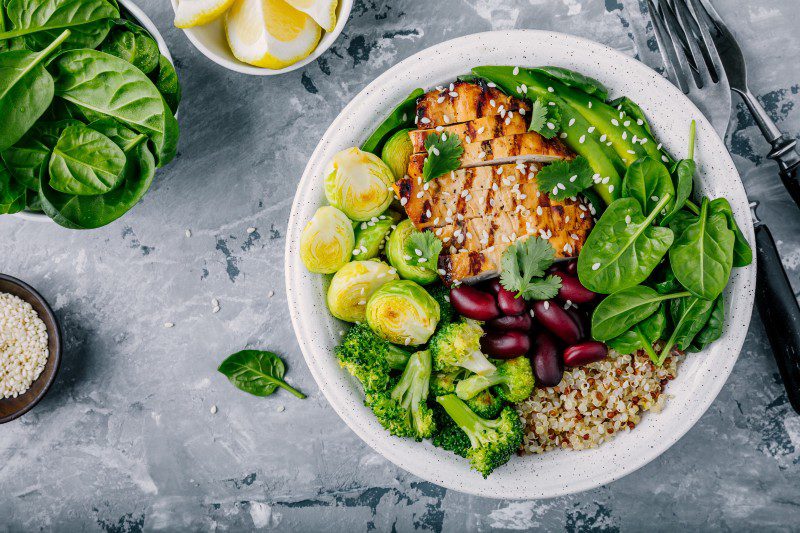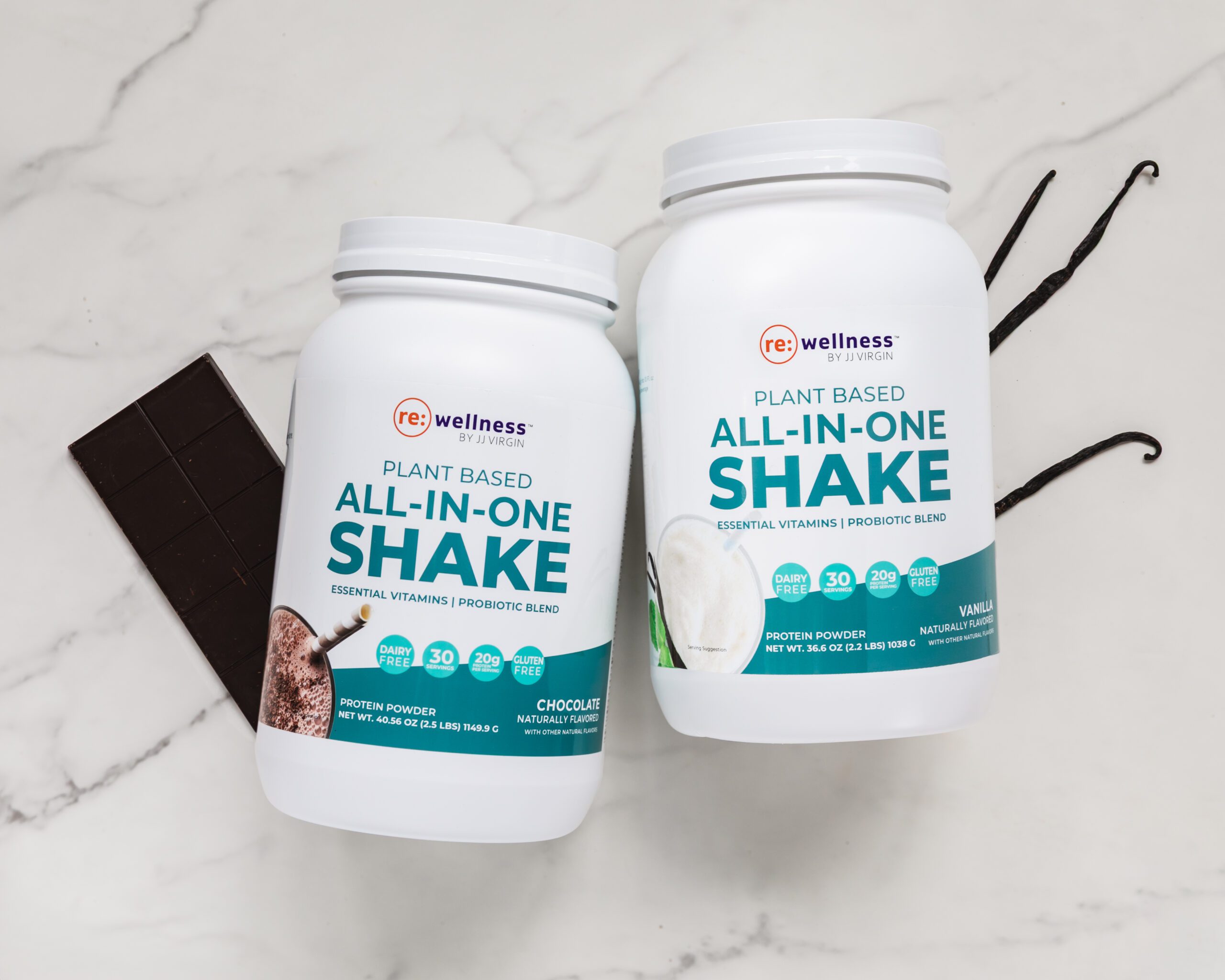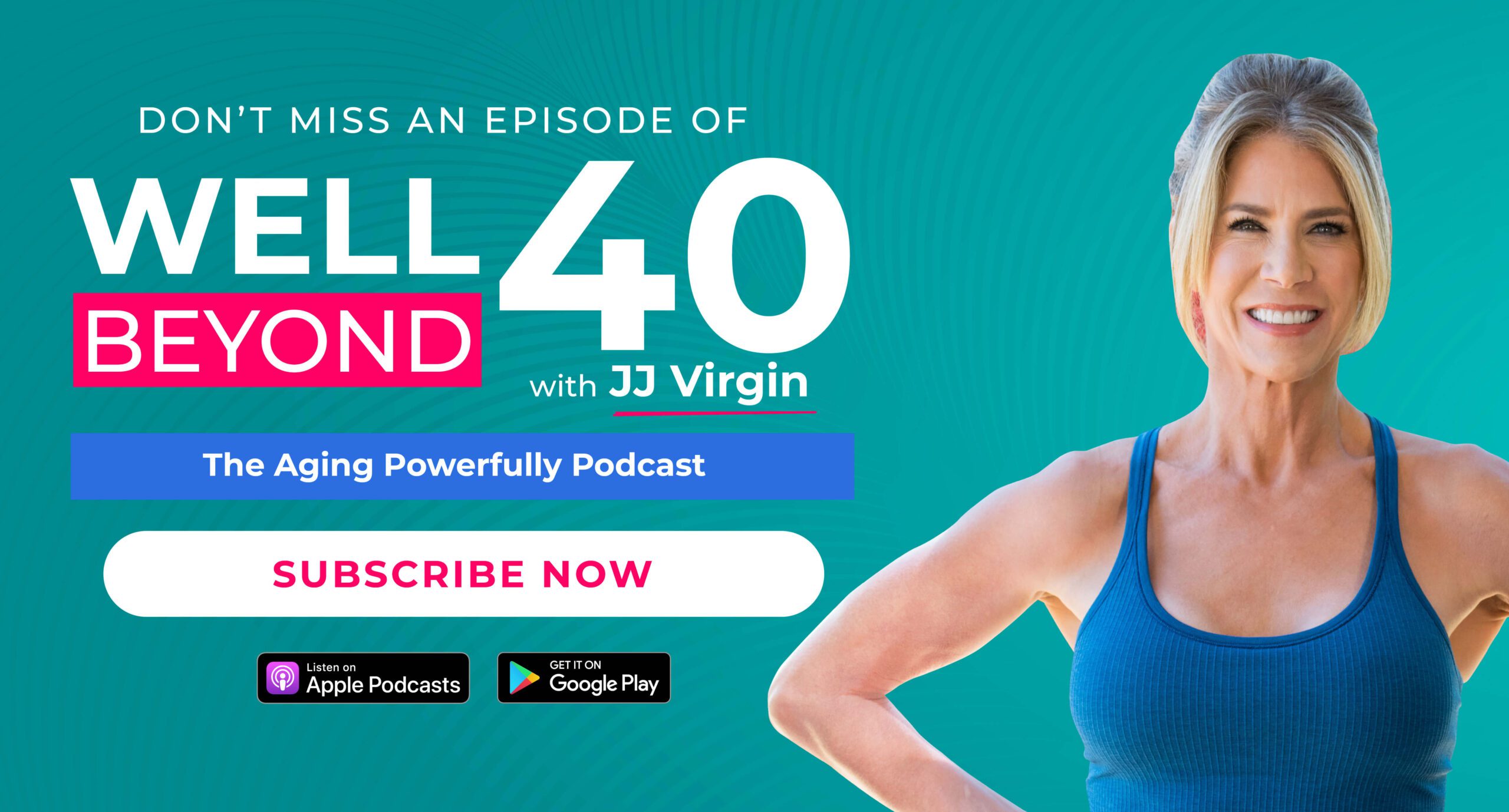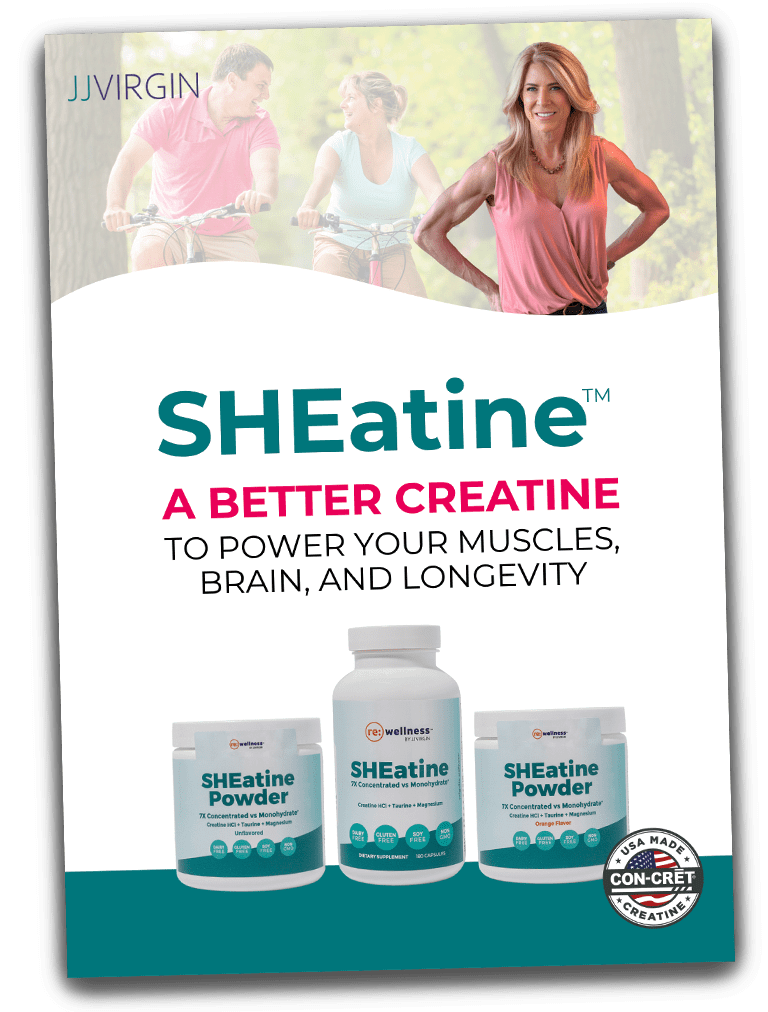I take a protein-first approach to every meal. Getting optimal amounts of protein helps repair and build muscle, reduce cravings, balance hormones, maintain blood sugar balance, and create vibrant skin, hair, and nails.
To get those and other benefits, you’ll want to aim for 30–50 grams of protein with every loaded smoothie and meal.
If it sounds like a lot of protein — listen up!
I’m asked all the time how to realistically fit that amount into each meal. Once you get the hang of it, meeting that daily quota becomes second nature.
Read on to learn a step-by-step strategy to optimize protein, starting with your very next loaded smoothie or meal.
1. Identify Your Proteins
Animal Protein
Animal protein will always trump plant-based protein. Amino acids are the building blocks of proteins, and we divide them into two categories:
- 11 non-essential amino acids, which the body can usually make on its own
- 9 essential amino acids, which the body cannot make on its own, so we must get them from food
Meat includes all the essential amino acids. That isn’t always the case with plant foods, which can be low or deficient in one or more essential amino acids.
Meat also tends to be more easily digested and absorbed than plant proteins. Animal protein sources have higher bioavailability, meaning that the body can utilize more of the nutrients that you consume.
Overall, meat contains higher amounts of protein, so you can meet your 100-gram quota quickly and efficiently. Six ounces of wild-caught salmon, grass-fed sirloin, and pastured chicken breast each has 30–40 grams of high-quality protein.
If you’re not intolerant, you might occasionally add eggs to this list (but don’t make this a regular habit). Three eggs have about 19 grams of high-quality protein.
Protein-Fueled Meat, Poultry & Fish Recipes
Plant-Based Protein
Right off the bat: you’re going to need to work harder to meet your 100-gram protein quota as a vegan or vegetarian. The good news is that it’s totally doable, but it requires a bit more focus.
Legumes, such as beans, lentils, and peas, are great vegan/vegetarian protein sources. Because they are low in one key amino acid (methionine), we call legumes incomplete proteins.
However, when you combine legumes with other protein sources (such as nuts and seeds), they become complete proteins. Plus, legumes are fiber heavyweights, keeping your blood sugar steady so you stay full and focused.
Your smartest legume choices include (measurements are for ½ cup cooked):
- Lentils: 12g protein
- Navy beans: 8g protein
- Cannellini beans: 8g protein
- Great northern beans: 8g protein
- Black beans: 8g protein
- Garbanzo beans (chickpeas): 8g protein
Protein-Packed Plant-Based Recipes
Note: while all of these contain some protein, it isn’t enough to hit your daily quota. A simple solution is to pair any of these recipes with the salad recipe below, which adds an additional 8 grams of protein per serving.
2. Boost Your Loaded Smoothies
My number one way to get more protein and hit your 100-gram quota? Break your morning fast with a loaded smoothie, with my All-In-One Shake as your base.
Whether you choose plant-based or paleo-inspired, you’re going to quickly see why I call this the most milkshake-like protein powder on the market. Every serving provides an impressive 20+ grams of protein, along with nutrients, fiber, and phytonutrients.
These protein-rich ingredients also give your loaded smoothie (or anywhere else you can add them) a serious boost:
- Chia seeds (2 tablespoons): 5g protein
- Flax seeds (2 tablespoons): 3g protein
- Avocado (1 medium): 3g protein
When you break your daily fast with a loaded smoothie, make sure you choose your protein powder wisely. A high-quality protein base should contain few ingredients, no or low sugar, and absolutely no Hi-FI foods.
Look for one that’s GMO-free and hormone-free if it’s you’re choosing an animal-based protein source as well. Avoid soy, egg, casein, or whey powders, many of which are also high in sugar and artificial sweeteners like fructose, high-fructose corn syrup, aspartame, or sucralose.
Want to upgrade your loaded smoothie? My go-to is collagen, a true multitasking protein that can help support proper bone density, skin health, joint tissue health, muscle strength, gut health + more! Collagen Peptides Powder is a convenient, effective way to add more protein to your plan… and it mixes easily into your loaded smoothie.
3. Bring in Non-Starchy Veggies
Non-starchy vegetables are nutrient rock stars, providing fiber, vitamins, minerals, antioxidants… and in some cases, protein. It may not seem like much, but every little bit counts!
The following protein counts are for 1 cup, cooked:
- Asparagus: 2g protein
- Brussels sprouts: 4g protein
- Shitake mushrooms: 2g protein
- Portobello mushrooms: 4g protein
- Broccoli: 3g protein
- Green beans: 2g protein
Non-Starchy Vegetable Recipes That Boost Your Protein Intake
- Roasted Brussels Sprouts With Bacon
- Paleo Steamed Broccoli With Garlic Oil Drizzle
- Virgin Stuffed Mushrooms
- Green Beans With Shiitakes and Shallots
4. Incorporate These Protein-Rich Slow Low Carbs
You’re probably not thinking protein when you enjoy slow low carbs, but let’s change that narrative. While the following foods aren’t protein superstars, they do have small amounts of this mighty nutrient:
- Gluten-free steel-cut oats (½ cup cooked): 5g protein
- Quinoa (½ cup cooked): 4g protein
- Wild rice (½ cup cooked): 3.5g protein
- Sweet potatoes (1 cup cooked): 2g protein
Protein-Rich Oats Recipes
Oats give you something a little chewier than a loaded smoothie to break your morning fast. I have four overnight oats recipes that combine steel-cut oats with other satisfying, good-for-you ingredients:
- Strawberries and Cream Overnight Oats
- Oatmeal Cookie Overnight Oats
- Cinnamon Almond Overnight Oats
- Triple Chocolate Blueberry Overnight Oats
Other Protein-Rich Slow Low Carbs Recipes
Quinoa also makes a versatile, protein-rich slow low carb, whether you’re serving up Hot Quinoa Cereal with Warm Berry Compote for breakfast or Quinoa Tabouli Salad to accompany your protein-fueled meal.
Alternately, this Wild Rice and Vegetable Pilaf combines wild rice with nutritious zucchini, squash, and red onions.
5. Go Nuts
A handful of nuts or seeds is a satisfying way to end any meal. They’re filled with healthy fats, fiber, nutrients, and yes, protein.
If you’re thinking, I’ll just have four servings so I can get quadruple amounts of protein… don’t! Too many nuts or seeds contain massive calories (and will probably give you a stomach ache), so go easy.
All protein amounts below are for about one ounce:
- Almonds: 6g protein
- Walnuts: 4g protein
- Brazil nuts: 4g protein
- Cashews: 5g protein
- Pistachios: 6g protein
- Sunflower seeds: 6g protein
- Pumpkin seeds: 7g protein
Protein-Boosting Nuts and Seeds Recipes
- Smoked Paprika and Cayenne Roasted Almonds
- Cinnamon Roasted Pecans
- Pumpkin Spice Roasted Pecans
- Freeze-Dried Fruit, Nut, and Seed Trail Mix
A fast, filling loaded smoothie is the perfect way to start your day. Need some yummy ideas? I’ve got over 60 recipes in my Loaded Smoothie Cookbook. It’s FREE… and guaranteed to be a game-changer for fat loss and overall health.
Putting a Plan Into Action
Now that you have some ideas about your best protein options from various food groups, let’s pull everything together and see how simple getting 100 grams of protein can be.
Here’s What a 100+-Gram Protein Day Looks Like as a Meat Eater
Meeting your 100-gram protein quota as an omnivore is a cakewalk! So let’s start your day with a Birthday Cake Shake.
Breakfast: JJ’s Birthday Cake Shake (33g protein)
Makes 1 serving
- 2 scoops All-In-One Shake (Chocolate or Vanilla)
- 10 oz unsweetened dairy-free milk of choice
- 1–2 tbsp raw cacao powder (optional)
- 1 tbsp coconut butter or oil
- 1 tbsp almond butter
- 2 tsp Extra Fiber, 1 tbsp chia seeds, or 1 tbsp freshly ground flaxseed meal
- 1 tsp real vanilla extract
- 1/8 tsp almond extract
- 4–5 ice cubes
Blend the ingredients together until smooth. Your shake can be thickened by adding ice cubes or thinned by adding cold water.
Lunch: 15-Minute Chicken & Quinoa Macro Bowls (60g protein)
Dinner: Flank Steak Bistro Chopped Salad (29g protein)
Total protein intake for the day: 122g
Here’s What a 100+-Gram Protein Day Looks Like as a Vegetarian or Vegan
Getting 100 grams of protein as a vegan or vegetarian is doable, although a bit more challenging. Lentils and other legumes, nuts, seeds, and nut butters provide the best protein sources and should be your mainstays. Use this one-day sample plan to guide your decisions.
Breakfast: Stress-Busting Chocolate Cherry Smoothie (36g protein)
Makes 1 serving
- 2 scoops All-In-One Shake (Chocolate)
- 1 cup dark, leafy greens (chard, kale)
- 1/2 avocado
- 1 cup frozen cherries
- 1 to 2 tbsp raw cacao powder (optional)
- 2 tsp Extra Fiber, 2 tbsp chia seeds or 2 tbsp freshly ground flaxseed meal
- 10 oz unsweetened dairy-free milk of choice
Combine all ingredients in a blender. Mix on high speed until smooth. Your smoothie can be thickened by adding ice cubes or thinned by adding cold water.
Lunch: Loaded Guacamole Buddha Bowl (33g protein with side salad)
Dinner: Vegetable Red Lentil Soup (39g with salad)
Side Salad (8g protein each serving)
Makes 1 serving
For the salad:
- 4–6 cups of mixed greens
- 1 cup shredded cabbage
- 1 small cucumber, sliced
- 1 small onion, thinly sliced
- 4–6 radishes, sliced
- 2 tbsp chopped walnuts
- ½ cup kimchi
For the dressing:
- 4 tbsp extra-virgin olive oil
- 1 tbsp apple cider vinegar or lemon juice
- Salt and pepper, to taste
Toss all salad ingredients in a bowl.
Whisk together dressing ingredients and drizzle desired amount over your salad. Refrigerate half for dinner.
Total protein intake for the day: 103g
With a little bit of planning, getting 100 grams of protein (and all the benefits that protein provides) becomes second nature. People are often amazed how much better they feel when they get optimal protein. They have more energy and focus, their skin glows, weight loss happens more easily, and they sleep more soundly.

*These statements have not been evaluated by the Food & Drug Administration. Products mentioned are not intended to diagnose, treat, cure, or prevent any disease. The views in this blog by JJ Virgin should never be used as a substitute for professional medical advice. Please work with a healthcare practitioner concerning any medical problem or concern.





